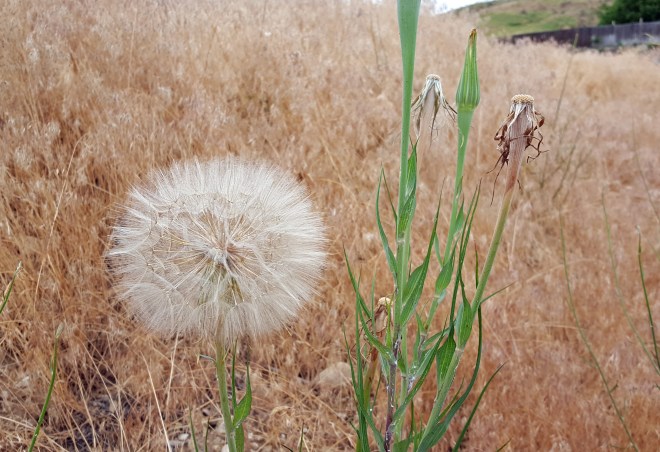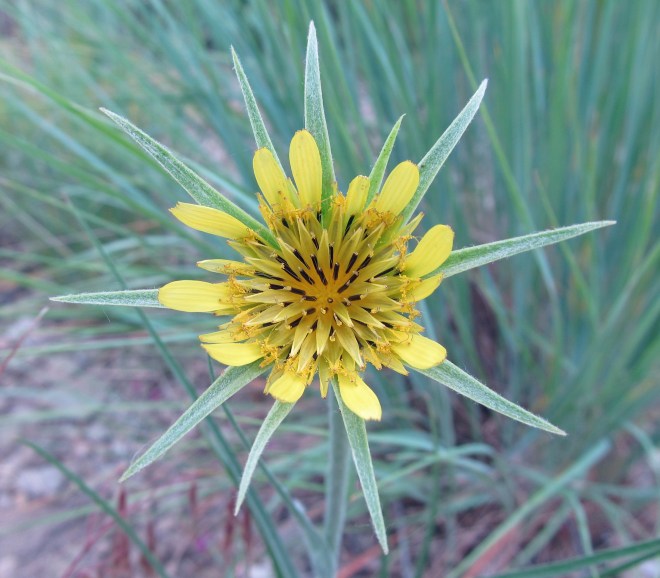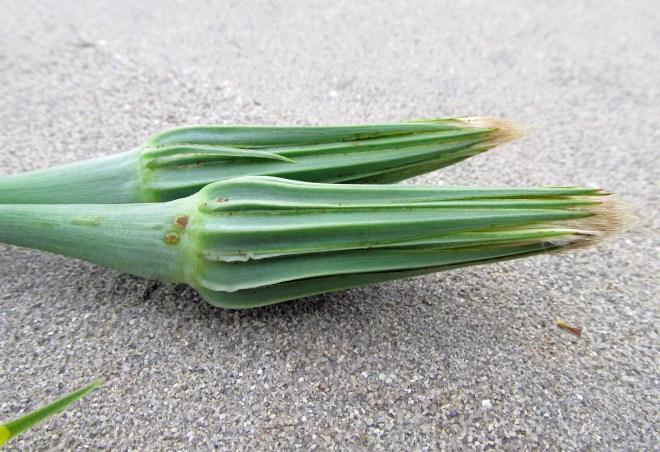Picking a favorite weed is challenging. If we dismiss entirely the idea that a person is not supposed to like weeds, the challenge is not that “favorite weeds” is an oxymoron; it is, instead, that it is impossibile to pick one weed among hundreds of weeds that is the most attractive, the most impressive, the most useful, the most forgiving, whatever. For me, salsify is a top contender.
Salsify and goatsbeard are two of several common names for plants in the genus Tragopogon. At least three species in this genus have been introduced to North America from Europe and Asia. All are now common weeds, widespread across the continent. All have, at some point, been cultivated intentionally for their edible roots and leaves, but Tragopogon porrifolius – commonly known as oyster plant or purple salsify – may be the only one that is intentionally grown in gardens today. Its purple flowers make it easy to determine between the other two species, which have yellow flowers.
As it turns out, I am not familiar with purple salsify. I don’t think it is as common in western North America as it is in other parts of the continent. In fact, the most common of the three in my corner of the world appears to be Tragopogon dubius, commonly known as western salsify. Tragopogon pratensis (meadow salsify) makes an appearance, but perhaps not as frequently. To complicate matters, hybridization is common in the genus, so it may be difficult to tell exactly what you are looking at.
Regardless, salsify is a fairly easy weed to identify. It is a biennial (sometimes annual, sometimes perennial) plant that starts out as a rosette of gray-green leaves that are grass-like in appearance. Eventually a flower stalk emerges, adorned with more grass-like leaves, branching out to form around a half dozen flower heads. Salsify is in the aster family, in which flower heads typically consist of a tight grouping of disc and ray florets. In this case, only ray florets are produced. The florets are yellow or lemon-yellow, and each flower head sits atop a series of pointed bracts which encase the flower (and the forming seed head) when closed. Examining the length of the bracts is one way to tell T. dubius (bracts extend beyond the petals) from T. pratensis (bracts and petals are equal in length).

Illustration of Tragopogon dubius by Amelia Hansen from The Book of Field and Roadside by John Eastman
The flowers of salsify open early in the morning and face the rising sun. By noon, they have usually closed. This phenomenon is the reason behind other common names like noonflower and Jack-go-to-bed-at-noon. Salsify’s timely flowering makes an appearance in Elizabeth Gilbert’s novel, The Signature of All Things: “Alma learned to tell time by the opening and closing of flowers. At five 0’clock in the morning, she noticed, the goatsbeard petals always unfolded. … At noon, the goatsbeard closed.”
The seed heads of salsify look like over-sized dandelions. Each seed (a.k.a. achene) is equipped with a formidable pappus, and with the help of a gust of wind, seeds can be dispersed hundreds of feet from the parent plant. The seeds don’t remain viable for very long, but with each plant producing a few hundred seeds and dispersing them far and wide, it is not hard to see why salsify has staying power.
Open, sunny areas are preferred by salsify, but it can grow in a variety of conditions. In The Book of Field and Roadside, John Eastman writes, “goatsbeards can establish themselves in bare soil, amid grasses and old-field vegetation, and in heavy ground litter; such adaptability permits them to thrive across a range of early plant successional stages.” Wild Urban Plants of the Northeast lists the following sites as “habitat prefrences” of meadow salsify: “abandoned grasslands, urban meadows, vacant lots, rubble dumps, and at the base of rock outcrops and stone walls.” While generally not considered a noxious weed, Tragopogon species are commonly encountered and widely naturalized. Last summer on a field trip to Mud Springs Ridge near Hells Canyon, salsify was one of only a small handful of introduced plants I observed looking right at home with the native flora.
All that being said, why is salsify one of my favorite weeds? Its simple and elegant form appeals to me. Its gray- or blue-green stems and leaves together with its unique, yellow flowers are particularly attractive to me. And its giant, globe-shaped seed heads, which seem to glisten in the sun, captivate me. Its not a difficult weed to get rid off. It generally pulls out pretty easily, and it’s a satisfying feeling when you can get it by the root. It’s a sneaky weed, popping up full grown inside of another plant and towering above it, making you wonder how you could have missed such an intrusion. The roots are said to be the most palatable before the plant flowers, so if you can spot the young rosette – disguised as grass and also edible – consider yourself lucky. I haven’t tried them yet, but I will. [Editor’s note: Sierra tells me that I have eaten them in a salad she made, but at the time I didn’t know they were in there so I don’t remember what they tasted like.] If they are any good, that will be one more reason why salsify is one of my favorite weeds.
Bonus excerpt from Emma Cooper’s book, Jade Pearls and Alien Eyeballs, regarding Tragopogon porrifolius:
Salsify is often called the vegetable oyster, because its roots are supposed to have an oyster-like flavor although I suspect nobody would be fooled. The long roots are pale and a bit like carrots – they are mild and sweet and when young can be eaten raw. Mature roots are better cooked. Traditionally a winter food, any roots left in the ground in spring will produce a flush of edible foliage.



I have grown salsify a couple of times in my vegetable garden. How do you pronounce it, sal si FEE or sal si fEYE?
Sal-sa-FEE – I just looked it up and discovered I’ve been pronouncing it wrong. I think Sal-sa-FIE must be a Southern interpretation. 🙂
I have always pronounced it sal si fEYE and have never considered pronouncing it any other way. Turns out there is another way to pronounce it. 🙂
I love salsify! The name itself is fun, as is the giant dandelion-style seedhead. Then you have the plant, which is just so elegant and pretty. Hopefully I’ll remember to dig up a few roots to cook this fall and will enjoy its other charms.
I feel the same way. I’m a big fan. 🙂
You picked a fun one! Your weeds series is great – can’t wait for the next one.
Glad you liked it! Thanks for reading!
Pingback: Concluding the Summer of Weeds – awkward botany
Not a favorite weed because it takes little time to take over wild meadow lands and push out wildflowers and grasses. And it becomes tall at least 4′ tall and rangy like a bush. The deer eat the flowers but not nearly enough to control the spread of these weeds.
Where do you live? Or where are you seeing this? In The Book of Field and Roadside, John Eastman writes, “Occasionally goat’s-beard [aka salsify] may form dense colonies, excluding less competitive species, but typically they occur in scattered, thinly dispersed stands.” I have only observed the “scattered, thinly dispersed stands” that Eastman refers to, so I would be curious to witness “dense colonies.” I don’t deny that they exist, I just have never seen them and would like to know where to find them. Thank you for your comment.
They are way-to-prevalent in our foothills of Salt Lake City.It’s very hard to get rid of once seeded. A bad weed in my opinion. Spoiling our natural landscape.
Is salsify to blame or disturbance caused by human activity? Why do opportunistic, enterprising plants so often become scapegoats for actions that are clearly no fault of their own?
I am searching to buy salsify seed; that is how I stumbled upon this site and this interesting conversation. As a child I was very fond of vegetable oyster soup from salsify grown in mother’s garden. Much time has passed; and that delicious soup comes to mind every now and then. I want to grow it.
This soup sounds delicious. I’m not sure where to get seeds, but I hope you are able to find some.
I was doing some research for our new seed catalog, and noticed your article on this. We are one of the small number of seed companies which carry these, and I do hope you were able to find some. If not, check our page at Burrell Seeds for some (although we carry the purple variety, rather than the yellow).
Did you know there are two more species of Tragopogon on the Palouse? They are the tetraploid hybrids of the original three introduced diploid species: T. miscellus and T. mirus. They are considered species in their own right because they can successfully reproduce with other plants like themselves but cannot backcross to the parental species. The majority of hybrids among members of this genus are sterile diploids but here on the Palouse there is something weird and different happening and so we have the tetraploids. So cool! Google “tragopogon triangle” for details…